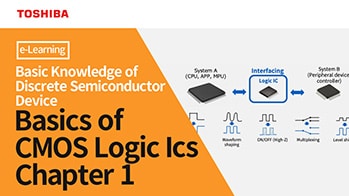- General Top
- SEMICONDUCTOR
- STORAGE
- COMPANY
-
My ToshibaSemicon
- Semiconductor Top
-
ApplicationsAutomotive
Body Electronics
xEV
In-Vehicle Infotainment
Advanced Driver-Assistance Systems (ADAS)
Chassis
IndustrialInfrastructure
BEMS/HEMS
Factory Automation
Commercial Equipment
Consumer/PersonalIoT Equipment
Healthcare
Wearable Device
Mobile
Computer Peripherals
-
ProductsAutomotive Devices
Discrete Semiconductor
Diodes
Transistors
Logic ICs
Analog Devices
Digital Devices
Wireless Devices
※
: Products list (parametric search)
Power SemiconductorsSiC Power Devices
※
: Products list (parametric search)
Isolators/Solid State RelaysPhotocouplers
Digital Isolators
Solid State Relays
Fiber Optic Transmitting Modules
※
: Products list (parametric search)
MOSFETsIGBTs/IEGTsBipolar Transistors※
: Products list (parametric search)
Diodes※
: Products list (parametric search)
MicrocontrollersMotor Driver ICsIntelligent Power ICs※
: Products list (parametric search)
Power Management ICsLinear ICs※
: Products list (parametric search)
General Purpose Logic ICsLinear Image SensorsOther Product ICsOther Product ICs
※
: Products list (parametric search)
-
Design & Development
-
Knowledge
- Where To Buy
- Part Number & Keyword Search
- Cross Reference Search
- Parametric Search
- Stock Check & Purchase
This webpage doesn't work with Internet Explorer. Please use the latest version of Google Chrome, Microsoft Edge, Mozilla Firefox or Safari.
require 3 characters or more. Search for multiple part numbers fromhere.
The information presented in this cross reference is based on TOSHIBA's selection criteria and should be treated as a suggestion only. Please carefully review the latest versions of all relevant information on the TOSHIBA products, including without limitation data sheets and validate all operating parameters of the TOSHIBA products to ensure that the suggested TOSHIBA products are truly compatible with your design and application.Please note that this cross reference is based on TOSHIBA's estimate of compatibility with other manufacturers' products, based on other manufacturers' published data, at the time the data was collected.TOSHIBA is not responsible for any incorrect or incomplete information. Information is subject to change at any time without notice.
require 3 characters or more.
How can I find the maximum operating frequency of a general-purpose logic IC?
If the seat of the general-purpose logic IC does not contain a description of the maximum operating frequency, the propagation delay time (tpLH, tpHL) can be roughly estimated using the following formula. Maximum operating frequency ≒ 1/ (tpLH + tpHL)
Table 1 shows the propagation delay times of representative products in each series and the results of the above formula.
Propagation delay times depend on the IC function. For ICs other than the typical ICs shown below, see the datasheet for propagation delay times and use them to calculate the maximum operating frequency. Propagation delay times also depend on wire lengths and loads in actual applications.
The maximum operating frequencies shown below should be considered only as a guide. Be sure to verify that the ICs you have selected operate properly under actual usage conditions.
Type |
Series Name |
CMOS Logic IC Series No. |
One-Gate Logic ( L-MOS ) Equivalents |
Operating Voltage Range |
Output current*2, IOUT (mA) |
tpLH ,tpHL( ns )*1 CL = 50pF |
Maximum Operating Frequency (Calculated value) (MHz) |
|---|---|---|---|---|---|---|---|
For 5-V Systems |
Standard |
3 to 18 |
±0.51 |
200 |
3 |
||
High Speed |
2 to 6 |
±4.0 or ±6.0 |
23 |
22 |
|||
4.5 to 5.5 |
31 |
17 |
|||||
Advanced |
- |
2 to 5.5 |
± 24 |
8.5 |
59 |
||
4.5 to 5.5 |
9.0 |
56 |
|||||
Very High Speed |
2 to 5.5 |
± 8.0 |
8.5 |
59 |
|||
10 |
50 |
||||||
9.5 |
53 |
||||||
4.5 to 5.5 |
8.5 |
59 |
|||||
For low voltage Systems |
Low Voltage |
1.8 to 5.5 |
± 16 |
6.5 |
77 |
||
| Very Low Voltage | 1.65 to 3.6 |
± 24 |
4.2 |
114 |
*1: Maximum propagation delay time of typical ICs (TC4001, TC74HC244, TC74HCT244, TC74AC244, TC74ACT244, 74VHC244, 74VHC9541 (An-Yn), VHCT244, VHCV244, 74LCX244, and TC74VCX244) at -40 to 85 °C, except for the TC4001 for which the maximum propagation delay time at 25 °C is shown.
*2: Those output current values are from DC Characteristics table of the datasheet. In addition, absolute maximum ratings also specify the current.
Related Links
The following documents also contain related information.




